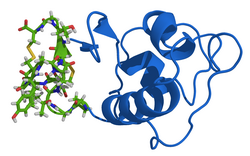Guanylin
| Guanylin | ||
|---|---|---|

|
||
| Proguanylin with guanylin (green) according to PDB 1O8R | ||
| Mass / length primary structure | 15 amino acids | |
| Precursor | Proguanylin (94 aa; 10.3 kDa) | |
| Identifier | ||
| Gene name (s) | GUCA2A; GUCA2; STARA | |
| External IDs | ||
| Occurrence | ||
| Parent taxon | Euteleostomi | |
| Orthologue | ||
| human | mouse | |
| Entrez | 2980 | |
| Ensemble | ENSG00000197273 | ENSMUSG00000023247 |
| UniProt | Q02747 | P33680 |
| Refseq (mRNA) | NM_033553 | NM_008190 |
| Refseq (protein) | NP_291031 | NP_032216 |
| Gene locus | Chr 1: 42.4 - 42.4 Mb | Chr 4: 119.31 - 119.31 Mb |
| PubMed search | 2980 |
|
Guanylin , also guanylate cyclase activator 2A ( GUCA2A ), like uroguanylin, is a peptide hormone .
discovery
The guanylin was first discovered in 1992 . It got this name because of its property of a certain receptor to activate guanylate cyclase-C (GC-C). A short time later, another ligand of this receptor was isolated from the urine of possums . According to its origin, it was named uroguanylin.
structure
Guanylin
Human guanylin (101-115) consists of 15 amino acids in the sequence Pro-Gly-Thr-Cys-Glu-Ile-Cys-Ala-Tyr-Ala-Ala-Cys-Thr-Gly-Cys. There are two disulfide bridges between Cys4 and Cys12 and between Cys7 and Cys15, which are essential for biological activity. The molecular formula is C 58 H 87 N 15 O 21 S 4 , the molecular mass is 1459 Da .
Uroguanylin
The human uroguanylin (96-112) consists of 16 amino acids in the sequence Asn-Asp-Asp-Cys-Glu-Leu-Cys-Val-Asp-Val-Ala-Cys-Thr-Gly-Cys-Leu. Uroguanylin also has the two disulfide bridges between Cys4 and Cys12 and between Cys7 and Cys15. The molecular formula is C 64 H 102 N 18 O 26 S 4 , the molecular mass is 1668 Da.
Both peptide hormones are similar to the enterotoxin (STa) from Escherichia coli . The amino acid sequence identity is 42% for guanylin and 57% for uroguanylin.
Mode of action
Both hormones are produced in the gastrointestinal lining (mucosa). By binding to an intestinal receptor, guanylate cyclase-C (GC-C), both hormones are involved in the regulation of the fluid and electrolyte balance as well as the uptake of nutrients in the intestine. Because of this property, they are also called natriuretic peptides. With the help of competition experiments it could be shown that both peptide hormones compete for the same binding site. Binding to an extracellular ligand binding site of this receptor triggers an increase in the messenger substance cGMP (cyclic guanosine monophosphate) in the cell. This leads to an increased secretion of chloride ions and an inhibition of the sodium chloride absorption. The result is the leakage of water into the intestinal lumen .
Both hormones show an activity that depends on the pH value . Guanylin is more active in an alkaline pH range, whereas uroguanylin is more active in an acidic pH range. This activity dependency on the pH value is consistent with the expression pattern of the two enzymes. So Guanylin is mainly from the duodenum (duodenum) to the colon to find (colon), whereas uroguanylin is the entire gastrointestinal tract, including the stomach before. Uroguanylin was also detected in the human kidney. Uroguanylin and guanylin can be detected in the distal tubules and collecting ducts.
The three-dimensional structure of the peptide hormones is mimicked by the heat-stable enterotoxins of the E. coli bacterial strains found in the human intestinal flora . However, the enterotoxins show about a hundred times more activity than uroguanylin and guanylin, which is probably due to their additional, third disulfide bridge. Due to this immensely higher activity, they cause an unnaturally strong flow of water into the intestinal lumen, which ultimately leads to severe watery diarrhea .
Others
A compound similar to uroguanylin is currently being investigated by a biopharmaceutical company. The drug candidate ( guanilib ) is expected to open the way to a new category of compounds known as guanylate cyclase receptor antagonists (GCRA) and provide new possibilities for the treatment of gastrointestinal diseases.
Individual evidence
- ↑ a b c M.G. Currie et al .: Guanylin: an endogenous activator of intestinal guanylate cyclase . In: Proc. Natl. Acad. Sci. USA . 89, 1992, pp. 947-951.
- ↑ a b c F.K. Hamra et al .: Uroguanylin: structure and activity of a second endogenous peptide that stimulates intestinal guanylate cyclase . In: Proc.Natl.Acad.Sci.USA 90, 1993, pp. 10464-10468.
- ↑ a b Peptanova chemical catalog.
- ↑ J: Klodt et al .: Synthesis, biological activity and isomerism of guanylate cyclase C-activating peptides guanylin and uroguanylin . In: J.Pept.Res. 50, 1997, pp. 222-230.
- ↑ a b L.R. Forte et al .: Guanylin peptides: cyclic GMP signaling mechanisms . In: Braz.J.Med.Biol.Res. 32, 1999, pp. 1329-1336.
- ↑ a b S.HW Chu, A. Walker: Bacterial toxin interaction with the developing intestine . In: Gastroenterology . 104, 1993, pp. 916-925.
- ^ NS Joo et al .: Regulation of intestinal Cl- and HCO3-secretion by uroguanylin . In: Am.J.Physiol. 274, 1998, pp. G633-G644.
- ^ S. Fujimoto et al .: Immunhistochemical Localization of Uroguanylin in the human kidney . In: Nephron . 84, 2000, pp. 88-89.
- ↑ a b I. Wollenschlaeger et al .: Localization of uroguanylin and guanylin in the human kidney . In: FASEB A579.10 . 1999.
- ^ UC Marx et al .: One peptide, two topologies: structure and interconversion dynamics of human uroguanylin isomers . In: J Pept Res. 52, 1998, pp. 229-240.
- ↑ Press release Callisto Pharmaceuticals Inc., ISIN US1312EM1041.